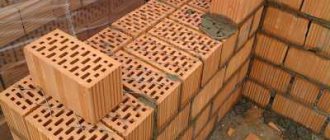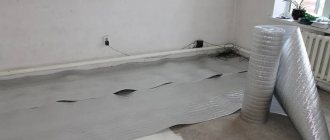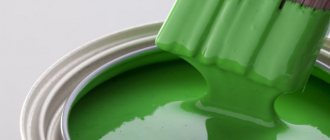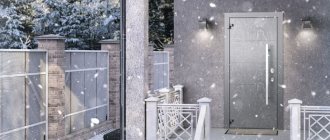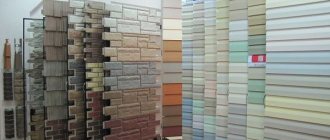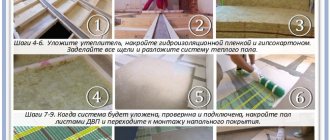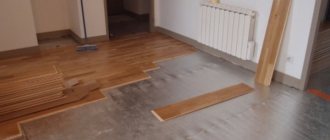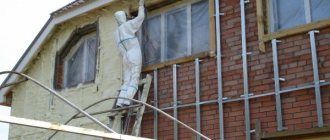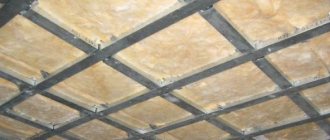Foamed polyethylene insulation also has another name - polyethylene foam (PPE). It is used to reduce the intensity of heat loss; in fact, this material is in many ways superior to some analogues, which is due to its closed-porous structure . PPE is characterized by a large number of positive qualities - minimal thickness, low thermal conductivity, etc. Insulation of this type is installed without unnecessary difficulties. In addition, the film is elastic, which allows better protection of complex surfaces.
Main characteristics and features of the material
The insulation is made from foamed polyethylene, which ensures its ability to protect surfaces from moisture. It represents a class of gas-filled thermoplastic polymers. The content of gaseous substances inside the pores helps to improve the thermal insulation properties. Another name for materials in this group is polymer foams and thermoplastics. To obtain PPE with the desired properties, high/low pressure polyethylene is used as a raw material. Different production technologies are used:
- direct extrusion;
- foaming of polyethylene material through a gaseous medium.
First, the raw material is melted at a temperature of +115 °C. When the desired consistency is achieved, add gas/nitrogen. Such substances contribute to the structuring of polyethylene.
The foaming process is implemented using the following methods:
- physical;
- chemical.
To avoid the formation of larger inclusions, the mass, consisting of gas-filled capsules, rotates continuously. After some time, the liquid material is poured into molds and cooled. Taking into account differences in production methods, different types of insulation are created:
- gas foam (not cross-linked);
- cross-linked foamed by physical/chemical means.
During the manufacture of the latter option, changes occur at the molecular level: a three-dimensional mesh is formed, which is possible after linking molecules and forming cross connections. If we consider insulation obtained by physical and chemical cross-linking, in this case there is no significant difference in the structure, but there is a difference in the production methods. The coating is made on the basis of foamed polyethylene in two versions: rolls, mats.
Insulation technology
Insulating a bathhouse with penofol
Heat can be lost in the following ways:
- through the floor;
- attic, if it is unheated;
- cracks in windows or doors if they are old wooden;
- through the walls if there are hidden cracks in them.
You can start insulating the room from the internal walls to heat up your apartment or house faster.
To insulate internal walls, it is better to use EPE foiled on one side. You can attach self-adhesive rolled materials to the wall or use a construction stapler.
Work order:
- Spread the roll on the floor and cut it to the required length according to the height of the walls.
- Using a stepladder, attach the top edge of the material to the wall.
- Next, straightening the PE from top to bottom, attach it with small nails with wide heads or a stapler. It is important that the foam insulation fits tightly to the wall.
The joints are connected using aluminum tape.
The second piece of polyethylene foam is applied end-to-end so that there are no empty spaces between the two sheets. After fixing all the joints, they are connected with aluminum tape to prevent heat loss.
To insulate windows and entrance doors, you can use strands of foamed polyethylene, which are sold in different diameters depending on the width of the cracks. The material may have an adhesive surface on one side, so the area is first treated with alcohol to degrease, then PE is attached. According to its characteristics, the new material is better than traditional foam rubber, which turns yellow over time and crumbles under the influence of heat.
It is not recommended to use foil material Penofol for laying under the screed for the following reasons:
- PE is thin and easily crushed under the weight of concrete, so the thermal conductivity characteristics are reduced to a minimum.
- There is nothing left of the foil after a month of use; in addition, it does not work in the absence of IR radiation under a layer of concrete.
- The floating thin screed, which does not have adhesion to the base due to the PE layer, begins to crack due to shrinkage, and along with it the tiles.
For laying under a concrete screed, a special multifoil with large cell sizes is used that do not deform under the weight of concrete.
How can you glue them together?
During the process of laying polyethylene foam, it may be necessary to glue the sheets to each other or to another material. Can be used:
- For connecting VPE – Acrol contact, Quick-Bond, Neoprene 2136, 88 NP.
- To glue foam plastic to another material or glue sheets of foam plastic together - Aqualit SK-106P, Polymin P-20, Super Master, Ceresit or Anserglob.
- To connect the VPE to the wall, it must be cleaned, treated with an antiseptic, dried, then use Nairit-1, Porolon-2, 88 Lux or 88-Metal glue.
Before starting work, you need to think through your actions and foresee what adhesives may be needed in the process.
Scope of application
Foam insulation is used in various industries, which is made possible due to its excellent thermal and sound insulation, as well as a number of other properties. Main areas of application:
- construction of facilities for various purposes;
- packaging material;
- furniture manufacturing;
- production of sports equipment;
- production line for prosthetic and orthopedic products;
- light industry;
- electrical engineering;
- Automotive industry;
- shipbuilding.
The use of foamed polyethylene is justified in any cases where it is necessary to provide protection from noise, reduce the intensity of heat loss, and also provide waterproofing.
The possibility of using insulation on different objects is due to its versatility. You should know that it is allowed to use cross-linked PPE, which was made by chemical or physical compounding, for the same purposes. This type of coating is used to insulate various objects, surfaces and objects, including:
- double glazed windows;
- doors;
- underlay for laminate;
- foundation;
- floor;
- walls;
- roof;
- ventilation systems;
- car interior, etc.
Installation
Installation of PPE is simple and convenient.
Polyethylene foam pipe insulation can be used in:
- cold and hot water supply systems;
- heating systems;
- sewerage;
- ventilation;
- as well as on pipes of refrigeration units.
The installation instructions are very simple.
If the pipeline is at the assembly stage , then:
- The shell is put on the pipe like a stocking.
- Then the joints are glued with special glue.
- Next, the joints are sealed with metallized tape.
The joints of the PPE are sealed with metallized tape.
If the pipeline is already assembled and welded , then:
Read also: What is ticked coloring?
- Each shell is cut to the size of a piece of pipe.
- Then it is cut lengthwise with a knife and put on the pipe through a side cut.
- The cut is sealed, the joints are also sealed.
- I also recommend gluing the material to the pipes at the joints.
It is easy to cut the shell lengthwise with a knife.
Comparison of manufacturers and prices
Insulation based on polyethylene foam is available in different price categories. Review of manufacturers and average prices:
- Penofol: 1400 rubles/roll – foil covering ( 3 mm, length 30 thousand mm), 2000 rubles/roll – insulation 10 mm thick, 15 thousand mm long.
- Tepofol: with a thickness of 2 mm, the cost is 400 rubles; thickness 5 mm – 1000 rub.
- Energoflex pipe insulation: 15 RUR/roll ( 22x9 mm); 145 RUR/roll ( 110/13 mm).
- Isoflex: 700 RUR/roll ( 25 m length, 2 mm thickness).
If you plan to insulate with polyethylene foam, you should know that the cost is influenced by a number of factors: thickness, length and width of the roll covering. In addition, PPE with a foil layer will cost more than insulation without heat-reflecting material.
Penofol
This is a multi-layer coating based on polyethylene foam. It is covered with a foil layer on one or both sides. This type of insulation may differ in density, structure and thickness. Foiled polyethylene foam has the advantage of additionally reflecting heat emanating from the room, thereby reducing heat loss. Characteristics of foam material:
- temperature regime: – 60 …+ 100 °C;
- high heat reflection coefficient (97%);
- low thermal conductivity – 0.035 W/(m*K).
Safety of polyethylene foam
Polyethylene is one of the most stable compounds on the planet. Polyethylene granules, which are used to make thermal insulation, are used to make water cans and bottles, food packaging, and water pipes.
At the household level, if used within the operating temperature range, polyethylene foam is harmless. PPE is dangerous when heated above 110-120 0C.
When burned, it releases acetic acid, formaldehyde, and carbon monoxide.
The decay period of the material is about 200 years. This, on the one hand, makes it one of the most durable materials (which is good). But on the other hand, polyethylene, like plastic, is a real disaster for the earth’s ecology, since a large amount of foamed polyethylene waste accumulates.
Foam film
Produced by foaming polystyrene. The coating is characterized by a low thermal conductivity, which makes it possible to use it for insulation of various objects. This type of foam material contains fire retardants. These are special additives that reduce the degree of exposure of the coating to high temperatures. Despite this, the foam film still burns. The insulation has a significant drawback - toxic compounds are released during the combustion process.
The coating retains heat and moisture well. However, it does not allow air to pass through.
The recommended insulation thickness for Russian regions varies between
20-25 cm. Additionally, a waterproofing diffuse material should be used, as well as a vapor barrier. Thanks to this, the foamed foam will be well protected from the effects of moisture contained in the indoor air.
Experimental evidence of the effectiveness of insulation
To clearly test the difference between different insulation materials, the following experiment was carried out:
- We assembled three wooden frames in the form of cubes with a volume of 1.5 m³.
- Each of the cubes was insulated with one of the insulation materials (Tepofol, stone wool and polystyrene foam) 100 mm thick, according to the technical recommendations of the manufacturers - Tepofol with welding of locks, cotton wool and polystyrene foam in two layers with an overlapping joint.
- All cubes were exposed to frost (-7 °C), the air inside was heated to 50 °C, and the power to the heaters was turned off.
- After 2 hours, the temperature in all cubes was measured. The welded Tepofol locks showed their effectiveness - the temperature inside “his” cube was 26.4 °C, while others dropped to 18.5 and 19.7 (EPS and cotton wool).
- Then the experiment was complicated - the air in the cubes was again heated to 50 °C and left to cool. But in addition they began to blow the cubes from industrial fans to simulate a strong wind.
- After another 2 hours, the temperature was measured again. The temperature inside the cube insulated with Tepofol was 21.5 °C, and in the rest - 5.5 and 11.5 (EPS and cotton wool, respectively).
Summary result of the experiment in the table:
Results of an experiment comparing insulation materials - table Source tepofol.ru
Since the thickness and thermal conductivity of all materials are approximately the same, we can draw an unambiguous conclusion - Tepofol insulation is effective thanks to its interlocking technology, which allows you to create a single, seamless, insulating layer.
Advantages and disadvantages
Insulation, characterized by a closed-cell structure, has many positive qualities:
- Versatility. The material is suitable for insulating various types of surfaces and objects.
- Excellent moisture and heat protection indicators.
- Foam coating is used as sound insulation if a material with a thickness of 5 mm or more is used.
- Light weight.
- Environmentally friendly.
- Vapor tightness.
- During combustion, the insulation does not emit toxic substances.
- Fungus and mold do not appear on the surface of PPE.
- The foam material is resistant to chemical compounds, which is important in construction.
- Elasticity.
- Elasticity.
- Reasonable price.
- Long service period.
The coating has much fewer disadvantages. These include low strength characteristics. The foam material is not resistant to compressive loads. For this reason, PPE is more often used to insulate horizontal surfaces. Under the influence of ultraviolet radiation, the insulation loses its properties, so it is either covered with a protective coating, or an option is used with a foil layer on top of the base material.
Tepofol after 5 years of operation: photo
The owners of a frame house built in 2009 became unwitting participants in an experiment comparing insulation materials. Already in the second winter season, heating costs increased significantly and it was decided to first add additional insulation to the house, and when the result turned out to be the same, change the insulation.
The house is a classic wooden frame with walls filled with insulation and exterior finishing. In the process of replacing the insulation, substandard NPE mats were used as filler inside the walls, and the outside of the house was completely wrapped in Tepofol, 50 mm thick. According to the owners, heating payments became minimal and could only increase due to energy prices.
After 5 years of operation, the Tepofol company turned to the owner of the house with a request to check how the insulation, which was installed without wind and vapor barriers, “feels”. With the consent of the owner, part of the wall was dismantled and the humidity level was measured in all its layers, which turned out to be normal - without any alarm signals in the form of mold or dampness.
Wall of a frame house 5 years after insulation with Tepofol Source tepofol.ru
On a note! Of course, it would be more clear to check the condition of the insulation after 20-30 years of operation, but so far there is only such data. On the other hand, the complete absence of any undesirable changes over 5 years already confirms that the use of Tepofol without wind and moisture protection is completely justified.
